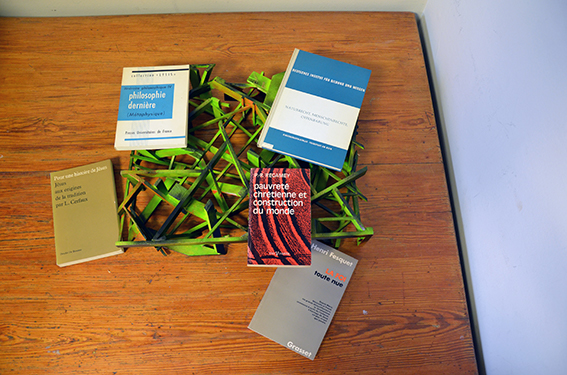Probably everybody at the Institute is familiar with the table. It can be found in some sort of waiting room (what is it philosophers are waiting for?) next to the main entrance to the building housing the library and auditoria. The table’s position is somewhat unusual since it is pushed in one of the room’s corners. It is not standing in the space in a way you expect of a table. You cannot walk around it, nor can you sit at it. If you want to use it while you are waiting, it is rather useless. There are no chairs around it. The best you can do is lean against it while waiting or discussing or doing whatever it is you are doing when you are waiting. Almost always the table is covered with books, or cardboard boxes filled with books. Occasionally you can also find miscellaneous items: used coffee cups, Styrofoam food containers, gloves, a writing pad, … But always there is a paper on the table (or it is hanging on the wall just above the table) containing useful information regarding the table, something like a guideline to use the table properly. It reads:
Gratis mee te nemen – free books
!! Dit is géén inleverbox – please do not leave your library loans here !!
The books on the table are put there by the library staff. They are books that have lost their place in the library collection. Too old, no longer relevant, subversive, double copies, unscientific, philosophically unsound, unsolicited, unwanted, not read anymore, out of philosophical fashion, … You can imagine loads of reasons why a university library pursues an active policy of elimination. Only the best academic work can be sure of a place in the book shelves of a knowledge community. So the table in the waiting room is not just a table with some books on it. The table shows the books, its titles and authors, that are no longer in full force competing in canon formation. It is the table of the washouts, the losers, the refugees. I imagine these books are looking for a shelter, a place to stay, a safe haven that would keep them from a recycling plant or a ritual book burning.
Even among the outcasts there is a clear hierarchy. Some are almost immediately adopted by an avid reader; chosen for a possibly meaningful new existence in some yet undetermined place. Some books simply have the right looks, the catchy title, the edgy graphic design that lifts them from anonymity. It is like paratext at work on the sorting table. To help the lesser endowed among them, something like a platform is put on the table. Perhaps more of these platforms will appear in different shapes, colours and styles, but at least now there is the possibility to lift some books out of the mass and to present them differently, to portray them more prominently. It is a stage for the book to perform, an elevation for knowledge no longer in vogue, a plinth to catch the eye. Of course the table is already a platform in its own right, but the same can be said of the floor and the wall. An overcrowded platform loses its capacity to single things out. So perhaps a little extra is needed to stand out from the crowd and to offer a frame against oblivion and transitoriness. It may be intricately useless, but at least it’s worth the try.




